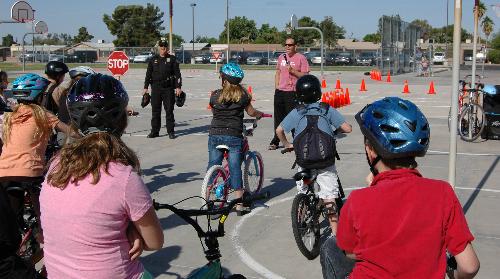

More than a decade ago California led the way for the “Safe Routes to School” movement, an international effort aimed at making it safer and more appealing for kids to use their own power to get to and from school. Mapping out routes, organizing groups of young walkers and bicyclists, and funding street and sidewalk improvements are some of the hallmarks of Safe Routes to School programs.
California was the first state in the country to pass a law providing money for Safe Routes to School programs in 1999. The programs became a permanent fixture with a 2007 law that ensured funding through the state transportation fund.
While some children walk or bike to school without an organized program, schools, parent groups and nonprofits can adopt formal programs to get more children on board and improve safety. Encouraging children to walk or bike to school is a simple way to promote exercise, help children arrive at school focused and ready to learn, and reduce air pollution and traffic congestion.
Despite all the advantages, we’ve found that school districts are sometimes afraid to launch a Safe Routes to School program. Why? Because they’re worried about being sued if an injury occurs.
But liability fears shouldn’t stop school districts from supporting these programs. There haven’t been any lawsuits involving an injury to a child in an organized Safe Routes to School program to date, even though there are programs in place at more than 4,500 schools across the country. Sports programs can actually pose more of a liability risk for schools – but schools understand that the relatively low risk and many benefits of sports programs are worth it. What’s more, California school districts that sponsor or endorse a Safe Routes to School program have “governmental immunity,” which offers more protection from a lawsuit.
School districts aren’t completely immune to liability risk, especially if they – rather than a community group or local agency – actively take responsibility for running the program. But there are many ways for anyone running a Safe Routes to School program to minimize the risk of liability. Some tips:
• Organize a “walking school bus” program, where parents or volunteers get basic training and walk a group of children to school.
• Avoid, repair, or eliminate potential hazards. If something is broken or poorly designed that could easily be fixed, do so or alert the agency that’s responsible for it. Can children avoid a hazard by entering and exiting the school through a different location? Can you work with the city or county to implement traffic-calming measures near the school? Document any steps you take to address possible hazards.
• Try to make sure any group that’s running the program has insurance that covers Safe Routes to School activities. In California, state PTA insurance may provide some coverage if the PTA has endorsed the program, although it doesn’t cover school districts directly.
• Be explicit about who holds responsibility. In California, school districts generally aren’t legally responsible for protecting students from harm on the way to and from school. If your program provides maps with “suggested” routes, explain in writing that program organizers do not guarantee the routes’ safety or take responsibility for the trip.
• Teach students safe pedestrian and bicycling practices. Local police, nonprofit organizations, and even bike shop staff can help provide safety trainings.
Liability fears tend to be overblown when it comes to Safe Routes to School programs. In fact, Safe Routes to School programs can actually lower schools’ exposure to liability by identifying potential dangers and putting measures in place to protect kids against injury.
By taking some commonsense precautions and addressing hazards responsibly, school districts, parent groups, and local agencies can launch Safe Routes to School programs to help give children the physical activity they need to be healthy and learn well.
Sara Zimmerman, JD, is a senior staff attorney at Public Health Law & Policy), a nonprofit research and training center based in Oakland, California.
Resources on assessing/minimizing liability risks:
http://www.nplanonline.org/childhood-obesity/products/SRTS-resources
The California Safe Routes to School State Network
California Department of Public Health’s Safe Routes to School Resource Center
Caltrans grants for Safe Routes to School programs
California’s Walk to School Day Headquarters
Photo from http://www.pedbikeimages.org/Mike Cynecki






You must be logged in to post a comment.